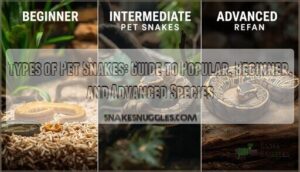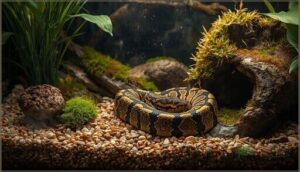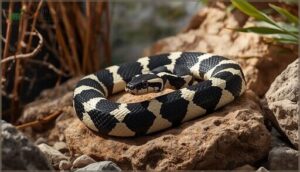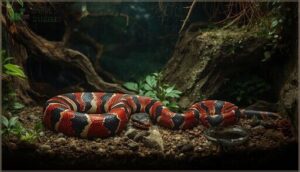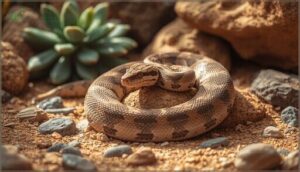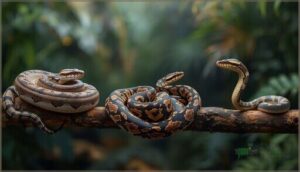This site is supported by our readers. We may earn a commission, at no cost to you, if you purchase through links.
Owning a snake isn’t for everyone, but for those drawn to these misunderstood animals, the commitment can be deeply rewarding. Unlike dogs or cats, snakes demand little time yet offer years of quiet companionship—some species live beyond 30 years.
The challenge lies in choosing wisely. A corn snake’s modest three-foot frame fits comfortably in a college dorm, while a reticulated python can outgrow your living room and demand rodents the size of rabbits. Temperament matters just as much: some species tolerate handling with calm indifference, while others strike defensively at the slightest disturbance.
Understanding which types of pet snakes match your experience level, space, and dedication prevents costly mistakes and ensures both you and your snake thrive together.
Table Of Contents
- Key Takeaways
- Popular Pet Snake Species
- Beginner-Friendly Snake Types
- Intermediate and Advanced Snake Species
- Snake Families Commonly Kept as Pets
- Choosing The Right Pet Snake
- Frequently Asked Questions (FAQs)
- What is the most pet friendly snake?
- What is the most affectionate pet snake?
- What is the most low maintenance snake?
- What is the most passive snake?
- What is the best snake for a beginner?
- What is the calmest snake to own?
- What type of snakes can be pets?
- How often do pet snakes need to be fed?
- Can different species of pet snakes live together?
- Do pet snakes recognize their owners?
- Conclusion
Key Takeaways
- Choosing the right pet snake depends on your experience, available space, and willingness to meet the specific needs of each species.
- Corn snakes, ball pythons, and garter snakes are highly recommended for beginners due to their docile temperaments, manageable sizes, and simple care routines.
- Intermediate and advanced species like red-tailed boas and reticulated pythons demand more experience and larger enclosures, making them best suited for dedicated keepers.
- Always consider local regulations, adult size, lifespan, and temperament to ensure a positive and lasting bond with your pet snake.
Popular Pet Snake Species
Choosing the right pet snake often starts with knowing which species are most popular with keepers. Each type has its own charm and care needs, so your experience can vary a lot depending on what you pick.
Here’s a look at some favorites that regularly top the list for new and seasoned owners alike.
Corn Snake
Corn snakes are a cornerstone of beginner snake care, thanks to their docile temperament and manageable enclosure size. Distinctive Corn snake morphs have captivated enthusiasts, while controlled feeding frequency prevents weight issues. Hybridization potential with other snake species, such as kingsnakes, adds genetic variety.
Corn snakes are beneficial because they control rodent populations in their native habitats.
Brumation process in captivity aids breeding cycles and keeps your snake healthy year after year.
Ball Python
Ball pythons are staples among popular pet snake species, valued for their steady temperament and adaptability. As a beginner snake, they offer intrigue with thousands of Morph Genetics options and reliable Feeding Habits.
Ball pythons thrive with proper humidity levels maintained in their enclosure. Proper snake care means keeping an eye on habitat enrichment and potential health concerns, while their approachable size and increasing market value make ball pythons a common first choice.
California Kingsnake
Kingsnakes bring variety and reliability to any collection. The California King Snake—famous for its striking color morphs and nonvenomous bite—is admired for venom resistance and manageable size. You can expect:
- Beginnerfriendly snakes, hardy in Captive Care
- Docile temperament with consistent Handling Tips
- Options for impressive color morphs
- Significant Invasive Impact in certain habitats
Milk Snake
If you appreciate variety, Milk and King Snakes offer a wide palette of Milk Snake Morphs—bands of red, black, and white, showcasing striking mimicry.
They thrive with routine Habitat Enrichment and respond well to gentle Handling Techniques after acclimation.
Observe their nocturnal Snake behavior; balanced Snake diet and nutrition, plus awareness of their breeding habits, boost longevity and safeguard Conservation Status.
Rosy Boa
Among beginner-friendly snake species, Rosy Boas stand out for their docile temperament and subtle, earth-toned patterns. Small yet sturdy, these nonvenomous snakes thrive in a desert habitat, rarely exceeding three feet—a manageable size variation with easy handling for most.
With proper care, expect an impressive captive lifespan and, during breeding season, the fascinating habit of giving birth to live young.
Western Hognose Snake
The Western Hognose Snake, a nonvenomous snake species with an upturned snout, brings personality to any collection. You’ll notice their signature burrowing and dramatic defensive behaviors early on—think bluffing more than biting.
Easy beginner snake care and the availability of striking Hognose morphs make them popular.
Prioritize habitat enrichment, understand their natural brumation cycle, and respect their stable conservation status.
Garter Snake
Curiosity often leads new keepers straight to the garter snake—a staple among beginner-friendly snake species. Garter temperament varies widely; some enjoy exploring, while others stick to hiding. These snakes adapt to a range of snake habitats, thrive on diverse snake diets, and come in countless morphs. Legal ownership generally poses few hurdles, but always verify state guidelines.
- Wide variation in Garter temperament and social behaviors
- Notable for easy Feeding habits and adaptable housing needs
- Richly diverse morphs/variations keep enthusiasts engaged
Beginner-Friendly Snake Types
If you’re thinking about starting with snakes, you’ll want a species that’s known for its easy care and calm nature. Some snakes are simply better for beginners than others.
Here are the top choices to help make your first experience a good one.
Key Traits for Beginners
If you’re sizing up beginner-friendly snake species, focus on those with a docile temperament, manageable size, and consistent feeding readiness. Docile snakes like corn snakes show calm behavior, making snake handling easier—essential for building your confidence.
Morph availability brings visual variety, while basic hardiness simplifies care routines. These qualities lower the difficulty of care, letting you enjoy the experience from the start.
Easiest Species to Care For
Looking to avoid beginner mistakes? Start with beginner-friendly snake species known for low maintenance. Docile snakes like corn snakes, ball pythons, and garter snakes thrive on regular, simple routines. Each is manageable in enclosure size, feeding schedules, and handling frequency. Choose one of these for a smooth start:
- Corn Snakes
- Ball Pythons
- California Kingsnakes
- Rosy Boas
- Garter Snakes
Temperament and Handling Ease
Ever wonder why some pet snakes seem almost relaxed in your hands? Decades of selective breeding for temperament make docile snakes like corn snakes and ball pythons ideal for beginners.
Gentle, steady handling two to three times weekly builds trust and reduces bite risk. Support your snake fully, respect its exploratory behaviors, and you’ll see temperament and handling ease improve—stress melts away.
Handle your snake gently two to three times weekly to build trust, reduce bite risk, and watch stress melt away
Intermediate and Advanced Snake Species
Some snakes truly stand out for their striking looks, complex care, or unique behaviors. If you’re ready for a new challenge, you’ll find several species that push your skills—and maybe your imagination—a little further.
Here are some intermediate snakes to think about, along with the enclosures they need.
Red-Tailed Boa
A RedTail Boa, one of the most recognized constrictors in the Boidae family, calls for commitment from keepers. With proper Boa Constrictor Care, you manage a snake that can exceed 10 feet and live up to 40 years.
Know your local Legal Restrictions—some places ban these giants. Temperament Concerns and Size Requirements factor into handling and preventing Health Problems.
Reticulated Python
If you’re considering the leap to Reticulated Pythons, be ready for true size extremes—adult length often surpasses 15 feet. Their temperament debate is ongoing; some individuals settle, others stay unpredictable.
With high enclosure needs, specialized feeding habits, and remarkable morph variations, these snakes challenge you. Sophisticated snake care knowledge is essential, given their sheer snake size and lifespan, plus the overall difficulty of care.
Brazilian Rainbow Boa
With Brazilian Rainbow Boas, you’ll see striking scale iridescence—a hallmark of their snake characteristics and features. This Boidae species is known for its docile Rainbow Boa Temperament, but young snakes can act defensive.
Prioritize Habitat Enrichment to maintain health and ease handling. Good, consistent feeding habits and attention to common Medical Concerns are central to successful snake care requirements for this species.
Green Tree Python
Green Tree Pythons attract you with their vivid color and arboreal grace, but specialized snake care is key. These snakes need vertical enclosures and consistent humidity to mimic wild habitat needs. Captive lifespan often reaches 15–20 years. Pay attention to:
- Temperature and humidity stability
- Proper feeding habits to prevent obesity
- Regular cleaning to avoid health issues
Their market price often reflects their appeal.
False Water Cobra
A False Water Cobra offers a distinctive combination of intermediate snake care challenges and striking looks. This semiaquatic snake species features impressive hood displays and moderate venom potency. Active captive behavior and high dietary needs demand a large enclosure. If you thrive on engagement, their snake temperament and handling quirks will keep you on your toes.
| Trait | Details |
|---|---|
| Venom Potency | Mild, caution needed |
| Hood Display | Defensive behavior |
| Enclosure Size | 10’ x 8’+ adult |
| Dietary Needs | Frequent, varied |
Asian Vine Snake
An Asian Vine Snake’s electric-green body and slender profile set it apart among arboreal snakes. Admire their camouflage, but be ready: wild-caught specimens often arrive with parasites and stubborn feeding habits.
Their Venom Potency is mild, yet Legal Restrictions exist in some regions. Like most developed snake species, their Captive Diet and Humidity Needs make care difficult, rewarding only committed keepers.
Water Snake
Water Snakes belong to the genus Nerodia and require a semiaquatic snake habitat that balances dry basking areas with water access.
Their Dietary Needs center on fish and amphibians—feeder goldfish work in captivity, though exclusively frozen options risk thiamine deficiency.
Temperament Concerns include defensive behavior when handled, demanding careful Handling Techniques.
Their Conservation Status varies, with some snake species facing trade pressures despite widespread populations.
Snake Families Commonly Kept as Pets
Most pet snakes fall into three main families, each with distinct characteristics that affect their care and suitability for different owners. Understanding these families helps you make informed decisions about which species align with your experience level and lifestyle.
Let’s look at the Boidae, Pythonidae, and Colubridae families to see what sets them apart.
Boidae Family Overview
The Boidae family includes 54 to 67 snake species across diverse habitats spanning the Americas, Africa, Asia, and Pacific islands. These constrictors display striking habitat diversity and unique reproductive traits—all boas give birth to live young rather than laying eggs.
You’ll find boa lifespan averaging 20 to 30 years, with captive breeding producing individuals reaching 40 years. Their feeding habits and Boidae behavior make several species excellent pet snakes.
Pythonidae Family Overview
The Pythonidae family encompasses 40 to 42 species across 10 genera, including popular pets like Ball Pythons, Reticulated Pythons, Burmese Python, and Blood Python.
Python habitats span sub-Saharan Africa, South and Southeast Asia, and Australia. Python size varies dramatically—from 61 cm to 9 meters—with most reaching 4 to 6 meters.
Python temperament is generally docile, making them suitable pets. Python lifespan reaches 15 to 20 years wild, 30+ captive.
Python care requires stable humidity and appropriate enclosures.
Colubridae Family Overview
Colubridae represents the largest snake family, comprising over 2,000 species across 249 genera—about 70% of all snakes worldwide. Colubrid diversity is striking, with habitat adaptations for terrestrial, arboreal, and aquatic environments. Popular pet species include corn snakes, milk and king snakes, kingsnake varieties, and black rat snakes.
Most colubrids have low venom potency, though exceptions exist. Reproduction strategies vary between egg-laying and live-bearing species. Conservation status ranges from stable to critically endangered.
Choosing The Right Pet Snake
Choosing the right pet snake isn’t just about picking the prettiest pattern or the most exotic species. You need to think through the practical realities of care, from how large your snake will grow to whether it’s even legal where you live.
Let’s break down the key factors that’ll help you make a smart, informed decision.
Size and Lifespan Considerations
Before you bring a snake home, you need to understand its adult length and life expectancy. Growth rate determines enclosure size requirements early on, while maximum size influences long-term costs.
Average lifespan varies greatly—corn snakes live 10 to 15 years, while rosy boas can exceed 30 years. Genetic diversity within captive populations also affects pet snake characteristics, impacting both snake size and snake lifespan expectations.
Temperament and Behavior
Snake temperament and behavior are just as important as physical traits. Captive behavior varies across species, with ball pythons curling defensively and corn snakes displaying curious, active patterns. Handling techniques improve through socialization effects, since routine exposure reduces stress.
Consider these factors:
- Defensive behavior frequency differs; corn snakes rarely strike when acclimated
- Selective breeding produces docile lines in boas and blood pythons
- Environmental factors like enclosure size influence activity levels
Aggressive behavior is uncommon in well-socialized specimens.
Feeding and Diet Needs
Feeding frequency and prey size matter tremendously when choosing your snake. Most species eat every one to two weeks, but juvenile snakes need meals every 5–10 days to fuel growth. You’ll offer appropriately sized prey—usually matching your snake’s head width—to support healthy digestion.
Dietary preferences vary: corn snakes thrive on rodents alone, while garter snakes require fish-based diets. Understanding these snake feeding habits prevents nutritional deficiencies and keeps feeding snakes straightforward.
Legal and Location Factors
Before choosing a pet snake, research permit requirements and species bans in your area. Local laws vary widely:
- Alabama prohibits venomous snakes except hognose species
- Florida bans Burmese and reticulated pythons
- Ohio restricts snakes over twelve feet long
- Texas requires permits for controlled exotic species
- Local ordinances may add further size limits or restrictions
International transport demands extensive paperwork and compliance with destination regulations.
Frequently Asked Questions (FAQs)
What is the most pet friendly snake?
Like choosing the right companion for a journey, selecting your first snake means finding a gentle guide.
Corn snakes and ball pythons are the most pet-friendly options, offering docile temperaments, easy handling, and low-maintenance care perfect for beginners.
What is the most affectionate pet snake?
Corn snakes and ball pythons show the most consistent temperament traits for handling sessions. Captive breeding has refined their stress markers, making them beginner-friendly snakes with adaptable snake behavior and temperament during regular interaction.
What is the most low maintenance snake?
Kenyan sand boas and California kingsnakes rank among low maintenance snakes with minimal care requirements.
These beginner-friendly snake species offer easy feeding habits, stable temperament suitability, and low cost ownership, making them ideal for new reptile keepers.
What is the most passive snake?
Ball pythons consistently top temperament scoring for pet snakes, thanks to rare bite incidents and strong beginner suitability. Their passive nature shows in low stress indicators during snake handling, making them a model among beginner-friendly, nonvenomous constrictors.
What is the best snake for a beginner?
If you’re a first time snake owner, the Corn Snake is a standout for its docile temperament, modest space requirements, and low cost.
Handling frequency is manageable, while its beginner-friendly care fosters mistakes and positive, confident ownership.
What is the calmest snake to own?
With pet snakes, ball pythons consistently top temperament metrics, showing low stress indicators and rare defensive behaviors.
Their gentle handling frequency, reliable beginner friendliness, and predictable calmness set the standard for beginner-friendly snake species and ease of care.
What type of snakes can be pets?
Snakes as pets include a variety of non-venomous, docile snakes such as Corn Snakes, Ball Pythons, Kingsnakes, and Rosy Boas.
Captive-bred species with manageable size and temperament represent popular, beginner-friendly choices, though snake legality varies.
How often do pet snakes need to be fed?
If you think snakes ring a dinner bell every evening, think again. Feeding frequency varies—juveniles eat more often than adults, prey size and seasonal factors matter, and overfeeding poses health risks.
Follow species-specific snake feeding guidelines for best health.
Can different species of pet snakes live together?
Different species of pet snakes shouldn’t share an enclosure. Cohabitation risks include aggression factors, mixed species compatibility issues, and significant health concerns.
Experts agree: single-species setups are safest, protecting snake behavior, temperament, and overall well-being.
Do pet snakes recognize their owners?
You’ll notice that snake behavior revolves around scent recognition and sensory discrimination rather than affection.
Through handling habituation and cognitive learning, your snake connects behavioral cues and routines to you, but doesn’t form emotional bonds like other pets.
Conclusion
Worried you won’t bond with a snake because they’re so different from typical pets? The truth is, many thrive on your calm presence and routine care, revealing their personalities over time.
Exploring the types of pet snakes opens up a world of reptiles suitable for nearly any lifestyle, from low-maintenance companions to fascinating challenges.
Select thoughtfully, considering your own needs as much as the animal’s, and you’ll find the right snake can quietly enrich your daily life for years.
- https://www.wiseguyreports.com/reports/pet-snakes-market
- https://www.chewy.com/education/reptile-and-amphibian/snake/best-pet-snakes
- https://www.reddit.com/r/snakes/comments/txyzvv/best_pet_snake_for_a_beginner/
- https://www.petsmart.com/learning-center/reptile-care/snake-care-guide-how-to-take-care-of-a-pet-snake./A0042.html
- https://www.petmd.com/reptile/pet-python-snake-care-sheet

